Pharmacological profile of the novel mammalian tachykinin, hemokinin 1
- PMID: 11786503
- PMCID: PMC1573107
- DOI: 10.1038/sj.bjp.0704443
Pharmacological profile of the novel mammalian tachykinin, hemokinin 1
Abstract
1. The effects of the novel mammalian tachykinin, hemokinin 1 (HEK-1), have been investigated by radioligand binding and functional in vitro and in vivo experiments. 2. Similar to SP (K(i)=0.13 nM), HEK-1 inhibited in a concentration-dependent manner and with high affinity [(3)H]-substance P (SP) binding to human NK(1) receptor (K(i)=0.175 nM) while its affinity for [(125)I]-neurokinin A (NKA) binding at human NK(2) receptor was markedly lower (K(i)=560 nM). 3. In isolated bioassays HEK-1 was a full agonist at tachykinin NK(1), NK(2) and NK(3) receptors. In the rat urinary bladder (RUB) HEK-1 was about 3 fold less potent than SP. In the rabbit pulmonary artery (RPA) HEK-1 and in the guinea-pig ileum (GPI), HEK-1 was about 500 fold less potent than NKA and NKB, respectively. 4. The responses to HEK-1 were antagonized by GR 82334 in RUB (pK(B)=5.6+/-0.07), by nepadutant in RPA (pK(B)=8.6+/-0.04) and by SR 142801 in GPI (pK(B)=9.0+/-0.2) with apparent affinities comparable to that measured against tachykinin NK(1), NK(2) and NK(3) receptor-selective agonists, respectively. 5. Intravenous HEK-1 produced dose-related decrease of blood pressure in anaesthetized guinea-pigs (ED(50)=0.1 nmol kg(-1)) and salivary secretion in anaesthetized rats (ED(50)=6 nmol kg(-1)) with potencies similar to that of SP. All these effects were blocked by the selective tachykinin NK(1) receptor antagonist, SR 140333. 6. We conclude that HEK-1 is a full agonist at tachykinin NK(1), NK(2) and NK(3) receptors, possesses a remarkable selectivity for NK(1) as compared to NK(2) or NK(3) receptors and acts in vivo experiments with potency similar to that of SP.
Figures
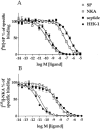
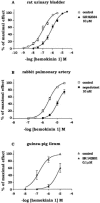
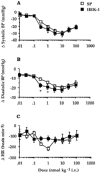
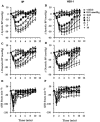

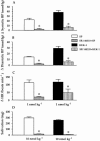
Similar articles
-
SCH 206272: a potent, orally active tachykinin NK(1), NK(2), and NK(3) receptor antagonist.Eur J Pharmacol. 2002 Aug 23;450(2):191-202. doi: 10.1016/s0014-2999(02)02124-6. Eur J Pharmacol. 2002. PMID: 12206858
-
MEN 11420 (Nepadutant), a novel glycosylated bicyclic peptide tachykinin NK2 receptor antagonist.Br J Pharmacol. 1998 Jan;123(1):81-91. doi: 10.1038/sj.bjp.0701587. Br J Pharmacol. 1998. PMID: 9484857 Free PMC article.
-
Pharmacological profile of hemokinin 1: a novel member of the tachykinin family.Life Sci. 2002 Jun 14;71(4):363-70. doi: 10.1016/s0024-3205(02)01682-x. Life Sci. 2002. PMID: 12044836
-
Neurokinin receptor subtypes characterized by biological assays.Life Sci. 1994;54(26):2035-47. doi: 10.1016/0024-3205(94)00712-8. Life Sci. 1994. PMID: 8208061 Review.
-
Molecular recognition of tachykinin receptor selective agonists: insights from structural studies.Mini Rev Med Chem. 2013 Dec;13(14):2036-46. doi: 10.2174/13895575113139990079. Mini Rev Med Chem. 2013. PMID: 23937231 Review.
Cited by
-
Truncated neurokinin-1 receptor is increased in colonic epithelial cells from patients with colitis-associated cancer.Proc Natl Acad Sci U S A. 2011 Oct 18;108(42):17420-5. doi: 10.1073/pnas.1114275108. Epub 2011 Oct 3. Proc Natl Acad Sci U S A. 2011. PMID: 21969570 Free PMC article.
-
Efficient synthesis of cyclic amidine-based fluorophores via 6π-electrocyclic ring closure.Chem Sci. 2020 Mar 13;11(14):3586-3591. doi: 10.1039/d0sc00798f. Chem Sci. 2020. PMID: 34094046 Free PMC article.
-
Mouse Hemokinin-1 Decapeptide Subjected to a Brain-specific Post-translational Modification.In Vivo. 2017 Sep-Oct;31(5):991-998. doi: 10.21873/invivo.11159. In Vivo. 2017. PMID: 28882971 Free PMC article.
-
Substance P modulates bone remodeling properties of murine osteoblasts and osteoclasts.Sci Rep. 2018 Jun 15;8(1):9199. doi: 10.1038/s41598-018-27432-y. Sci Rep. 2018. PMID: 29907830 Free PMC article.
-
Expression and function of human hemokinin-1 in human and guinea pig airways.Respir Res. 2010 Oct 7;11(1):139. doi: 10.1186/1465-9921-11-139. Respir Res. 2010. PMID: 20929541 Free PMC article.
References
-
- BRADFORD M.M. A rapid and sensitive method for the quantitation of microgram quantities of protein utilising the principle of protein-dye binding. Anal. Biochem. 1976;75:248–254. - PubMed
-
- BREMER A.A., TANSKY M.F., WU M., BOYD N.D., LEEMAN S.E. Direct evidence for the interaction of neurokinin A with the tachykinin NK(1) receptor in tissue. Eur. J. Pharmacol. 2001;423:143–147. - PubMed
-
- CASCIERI M., HUANG R.R., FONG T.M., CHEUNG A.H., SADOWSKI S., BER E., STRADER C. Determination of the aminoacid residues in substance P conferring selectivity and specificity for the rat neurokinin receptors. Mol. Pharmacol. 1992;41:1096–1099. - PubMed
-
- CATALIOTO R-M., CRISCUOLI M., CUCCHI P., GIACHETTI A., GIANNOTTI D., GIULIANI S., LECCI A., LIPPI A., PATACCHINI R., QUARTARA L., RENZETTI A.R., TRAMONTANA M., ARCAMONE F., MAGGI C.A. MEN 11420 (nepadutant), a novel glycosylated bicyclic peptide tachykinin NK2 receptor antagonist. Br. J. Pharmacol. 1998;123:81–91. - PMC - PubMed
-
- CHENG Y., PRUSOFF W. H. Relationship between the inhibition constant (Ki) and the concentration of inhibitor which causes 50% inhibition (IC50) of an enzymatic reaction. Biochem. Pharmacol. 1973;22:3099–3108. - PubMed
MeSH terms
Substances
LinkOut - more resources
Full Text Sources
Other Literature Sources
Molecular Biology Databases
Research Materials
Miscellaneous

